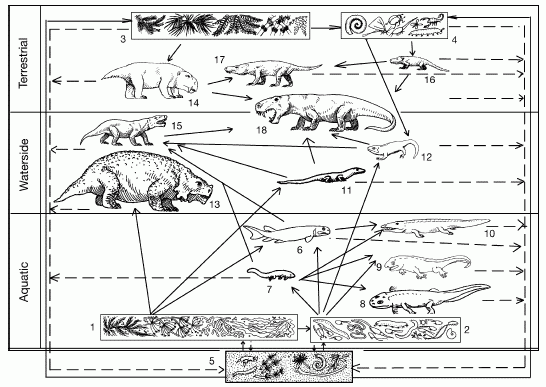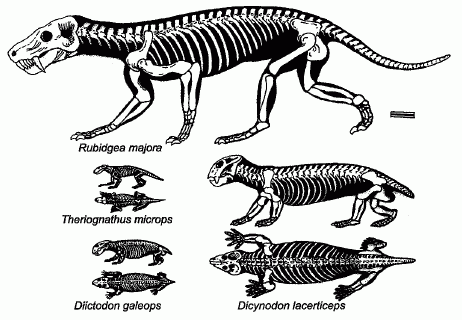
| Lopingian Epoch | ||
| Paleozoic: Permian Period |
Changhsingian |
| Wuchiapingian | Guadalupian | Lopingian | ||
| Induan | Early Triassic | Time |
Also spelt Changxingian.
this page is still under construction....


As explained by Tverdokhlebov et. al.:
The latest Tatarian Vyatkian Community (Kutulukskaya and Kulchumovskaya svitas; Fig. 22) continued at a similar level of complexity. The aquatic component is comparable to previous examples; the fishes and larval tetrapods were fed on by the reptiliomorphs Microphon, Dvinosaurus, Karpinskiosaurus, and the chroniosuchids Chroniosuchus, Jarilinus, and Uralerpeton. Small herbivores on land include unnamed tokosaurids. Larger herbivores are the dicynodont Dicynodon and the pareiasaur Scutosaurus. Terrestrial carnivores include the reptiliomorph Chthonosaurus, the therocephalians Annatherapsidus and Scylacosuchus, and the procynosuchid cynodont Uralocynodon. The top carnivore, capable of preying on the largest of contemporary herbivores was the gorgonopsian Inostrancevia. Immediately following the end-Permian environmental catastrophe, earliest Triassic faunas consisted only of a few fish taxa and small, aquatic tetrapods, in low-diversity, low-abundance assemblages.
During this time, two new large predator families appear - the proterosuchid thecodonts archosauriforms) and the therapsid moschorhinids (therocephalians). The latter make up about half the predator specimens in the latest Daptocephalus Zone faunas (late Wuchiapingian-early Changhsingian).
The Changhsingian age began with the continuation of the successful Therapsid communities of the preceeding Wuchiapingian age. As time progressed, massive vulcanism in what is now Siberia (the Siberian Traps), perhaps in association with other factors, resulted in dramatic greenhouse conditions, with increasing atmospheric carbon dioxide and methane, and decreasing amounts of oxygen Retallack 2005 Retallack et al 2006. The increasingly harsh conditions began to take their toll on the biota, culminating in the worst mass extinction in the histrory of advanced life on Earth.
Unlike the End-Cretaceous Extinction, in which dinosaurs and other animals remained common until the obvious asteroid impact, there seems to have been a gradual decrease in biodoversity, at least as far as terrestrial animals went, culminating in a sudden dramatic extinction that ravaged what was left of the already impoverished fauna Ward et al. 2005. Only those animls that were already pre-adapted for low oxygen conditions, such as burrowers like Lystrosaurus, were able to make it through.Retallack et al 2003
 (Left) Representative animals (drawn to scale) from the latest Permian of Gondwana (These fossil animals are from near Bethulie, Orange Free State, Southern Africa). Scale bar 10 cm.
(Left) Representative animals (drawn to scale) from the latest Permian of Gondwana (These fossil animals are from near Bethulie, Orange Free State, Southern Africa). Scale bar 10 cm.
Featured here are Rubigea majora, a 3 meter long Gorgonopsian therapsid and superpreditor of its environment, Theriognathus microps, a tiny but advanced Therocephalian (Family: Whaitsiidae), and - , making up the herbivore contingent. - an abundant small and common large Dicynodont